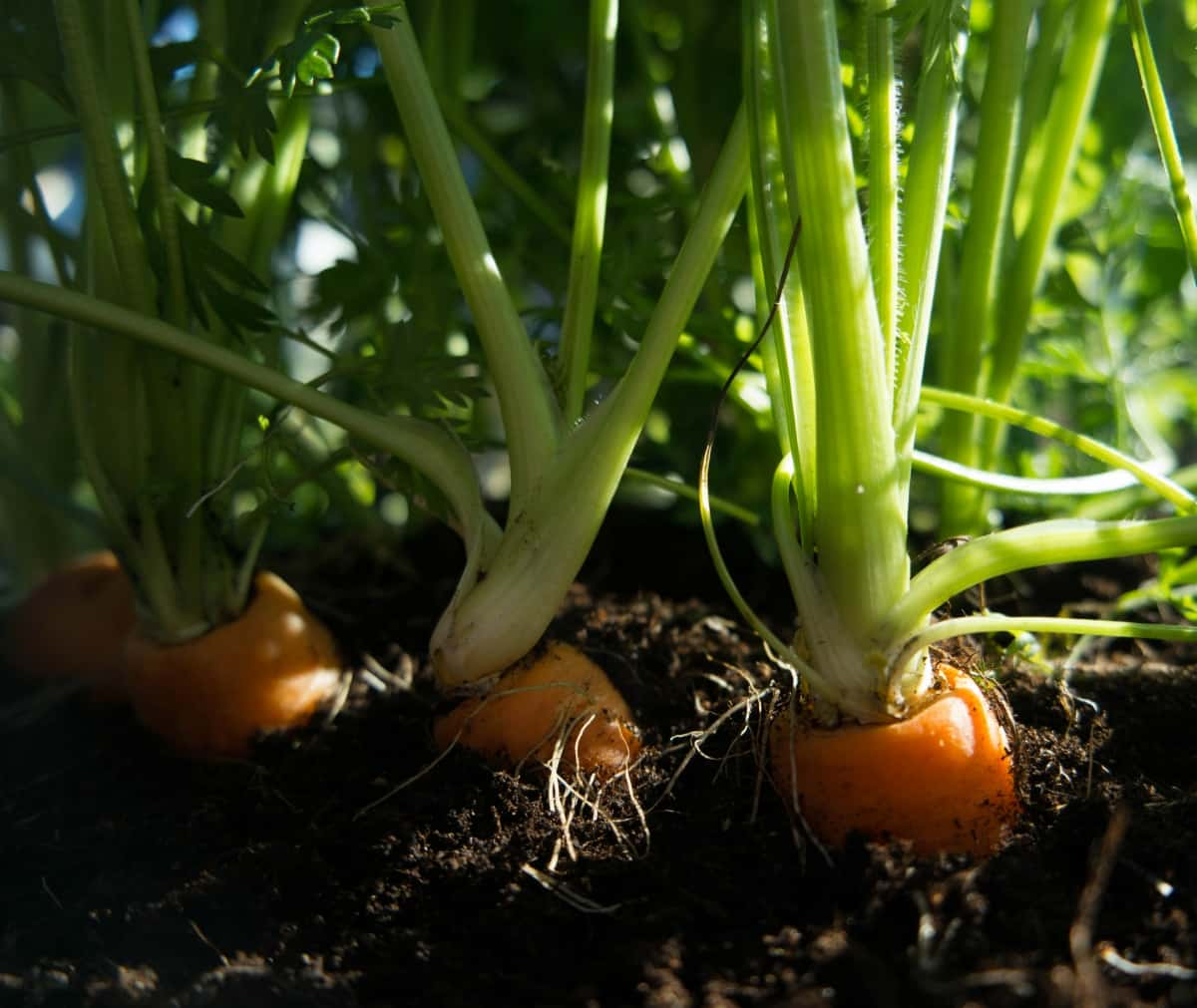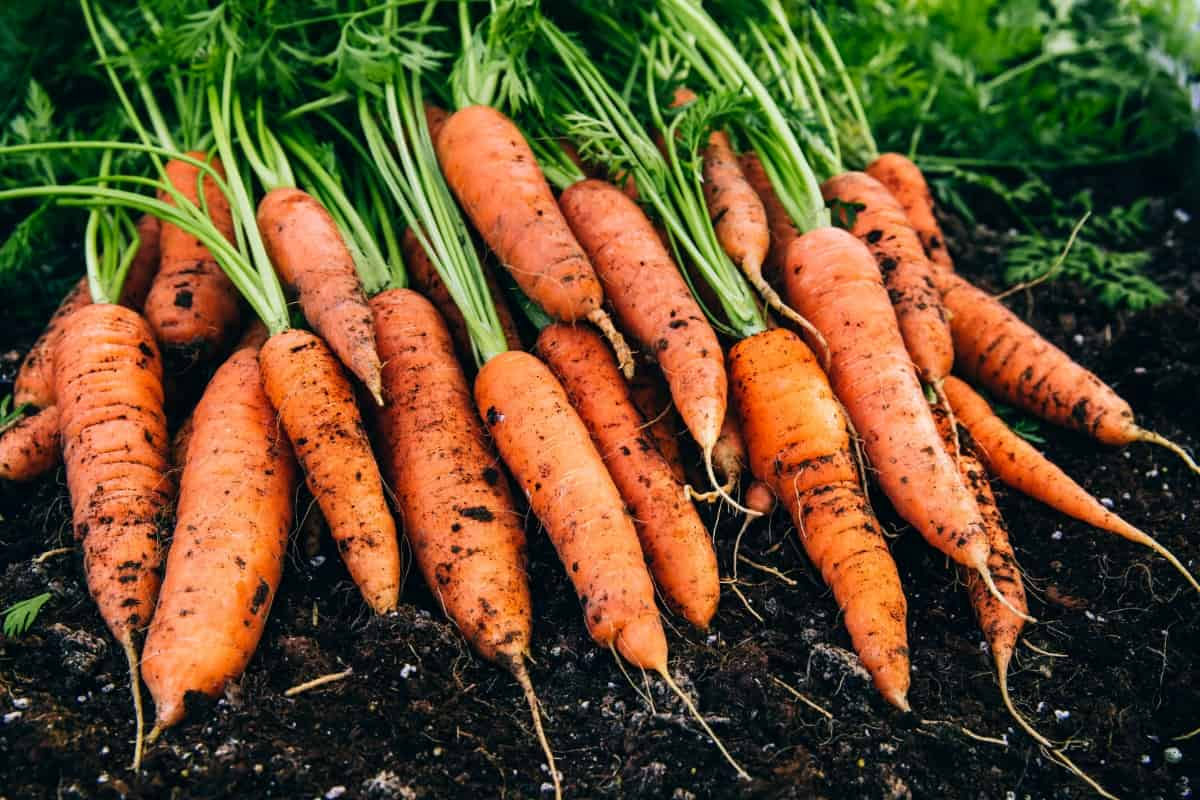Carrots rank among the frequently cultivated vegetables in residential gardens. They are nutritious, versatile, and potentially flourish with the right carrot companion plants in their growing environment. But what grows well with carrot? That’s where this comprehensive guide to companion planting for carrots comes in handy. As you dive deeper, you’ll see the best companion carrot plants that can benefit their growth and yield.

Benefits of Companion Plants for Carrots in the Garden
Companion planting strategically places different types of plants close together for mutual benefit. When it comes to carrots, certain plants can provide various advantages. These carrot companion plants’ benefits include deterring pests, promoting pollination, improving soil fertility, and enhancing overall plant health. Companion planting in your garden creates a more biodiverse and visually appealing environment. It’s all about creating a mini-ecosystem where every plant supports and benefits one another.
Best Companion Plants for Carrots to Deter Pests
When grown near certain plants, carrots can experience a reduction in pests. Companion plants for carrots that help deter pests often emit strong odors or chemicals that repel harmful insects. For example, aromatic herbs such as sage, rosemary, and chives are known to deter the carrot fly, a common pest. Planting these herbs alongside your carrot beds can provide natural and effective pest control. Similarly, leeks can deter carrot flies, while carrots can deter leek moths, making them beneficial companions.
Carrot Companion Plants for Improved Pollination
Pollination is crucial for the yield of many vegetables, and companion planting can play a vital role here. Plants like dill and coriander can help improve carrot pollination. These plants attract advantageous insects like bees and butterflies, leading to improved pollination and higher carrot yield in your garden. It’s worth noting that although carrots are root vegetables and do not require pollination to produce the edible root, their flowering tops can attract pollinators that benefit the entire garden.
Companion Plants for Carrots in Containers
Companion planting can be equally effective in containers, making it suitable for gardeners with limited space. Small herbs like chives, parsley, and radishes can be grown alongside carrots in pots or containers. Not only do they save space, but these companions also offer carrot companion plants benefits such as deterring pests and aiding in growth. However, caution about what you should not plant next to the carrot is needed. Some plants, like dill or fennel, might not make good container companions due to their large size and aggressive growth habits.
In case you missed it: 10 Common Problems With Garden-Grown Carrot Plants: Treatment and Solutions

Companion Herbs for Carrots in Organic Gardening
In organic gardening, where synthetic pesticides and fertilizers are avoided, companion herbs for carrots can provide immense value. Herbs such as sage, rosemary, and chives deter pests and enrich the soil with essential nutrients, promoting the overall health of your carrots. Other beneficial herbs include parsley and coriander, which attract beneficial insects, further enhancing your organic gardening efforts.
Flowering Companion Plants for Carrots to Attract Beneficial Insects
Attracting beneficial insects is another advantage of companion planting. Flowering plants, in particular, can attract insects such as ladybugs, lacewings, and hoverflies, which are known to control pests. Marigold, calendula, and nasturtiums are flowering plants that can be grown alongside carrots. These flowering companion plants enhance your garden’s aesthetics while attracting beneficial insects for pest control and pollination.
Companion Vegetables for Carrots in Raised Beds
Raised beds are excellent for growing carrots, and companion planting can improve results. Tomato, lettuce, and radish are great companion vegetables for carrots in raised beds. Tomatoes deter carrot flies, while radishes aid soil aeration, facilitating optimal growth of carrot roots. It is also worth considering that certain plants are bad carrot companion plants. Examples include potatoes and celery, which compete for nutrients and space.
Companion Plants for Carrots to Improve Soil Fertility
Certain plants can improve soil fertility, which enhances carrots’ growth. Beans and peas, for instance, fix nitrogen in the soil, providing an essential nutrient for carrots. Additionally, plants with deep roots, such as alfalfa, can bring up nutrients deep in the soil, enriching the surface soil where carrots grow. These companion plants can significantly contribute to a healthier and more productive carrot crop.
Companion Plants Chart for Carrots in the Garden
A companion plants chart can be highly beneficial to simplify the process of selecting companion plants for carrots. Here’s a brief example:
- Good Companions: Sage, Rosemary, Chives, Dill, Coriander, Leeks, Marigold, Calendula, Nasturtium, Tomato, Lettuce, Radish, Beans, Peas, Alfalfa.
- Bad Companions: Dill (in containers), Fennel (in containers), Potatoes, Celery.
Remember, this chart is not limited, and the companion plants for carrots can vary based on your specific garden conditions and needs. Experimenting with combinations can help you find what works best in your garden. Remember to ask, “What grows well with carrots?” and you’ll soon develop a thriving, mutually beneficial garden ecosystem.
In case you missed it: Common Carrot Damaging Diseases: Identification, Treatment, Management, and Control

Companion Plants for Carrots to Enhance Flavor
Another exciting aspect of companion planting is the potential enhancement of flavor. Certain plants can subtly influence the taste of neighboring plants through their root exudates and scent. For example, planting onions and leeks near carrots can improve their taste. However, be aware that not all plants have this effect, and some can be detrimental to the taste of your carrots. As always, it’s essential to research and experiment to find the best companion plants for carrots in your garden.
Companion Plants for Carrots to Promote Healthy Growth
Several plants can promote healthy growth when grown alongside carrots. These plants often provide physical benefits such as shade, wind protection, or soil structure improvements. For example, taller plants like tomatoes can provide the necessary shade for carrots during hot summer days. Similarly, plants with different root structures, such as radishes, can help aerate the soil and prevent compaction, providing a healthier environment for carrot roots to develop.
Carrot Companion Plants for Enhanced Garden Biodiversity
Carrot companion plants can significantly contribute to garden biodiversity. Diversifying your garden by growing various plants can create a more balanced and resilient ecosystem. For example, incorporating flowering plants like nasturtium and marigold with your carrots can attract a wider variety of beneficial insects, improving pollination and pest control. Similarly, different herbs can attract specific types of wildlife, contributing to a richer and more balanced garden ecosystem.
In case you missed it: How to Grow Baby Carrots at Home: A Guide to Planting to Harvest

Conclusion
Understanding and implementing the concept of companion planting with carrots can significantly benefit your garden. The practice encourages biodiversity, deters pests, promotes pollination, and can even enhance the flavor of your carrots. Remember, though, that not all plants are compatible.
Be aware of bad companion plants for carrots, and ensure you research and consider your specific garden conditions before implementing any companion planting scheme. As with many aspects of gardening, companion planting is as much an art as a science, and some trial and error may be required to find the best combinations for your unique garden environment. Keep experimenting, and soon you’ll find a mix that leads to healthier and more abundant crops.
- Feed Your Flock for Less: Top 10 Tips to Save on Chicken Feed
- Ultimate Guide to Ossabaw Island Hog: Breeding, Raising, Diet, and Care
- Hatching Answers: The Top 10 Reasons Your Chickens Aren’t Laying Eggs
- Eggs and Economics: Breaking Down the Cost of Raising Backyard Chickens
- Defend Your Greens: Proven Methods to Keep Iguanas Out of Your Garden
- Ultimate Guide to Cinnamon Queen Chicken: A Comprehensive Guide for Beginners
- Ultimate Guide to California Tan Chicken: Breeding, Raising, Diet, Egg-Production and Care
- Ultimate Guide to Marsh Daisy Chicken: Breeding, Raising, Diet, and Care
- 10 Types of Chicken Farming Businesses You Can Start for Profits